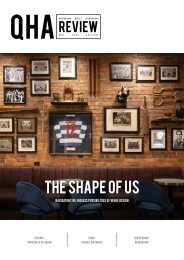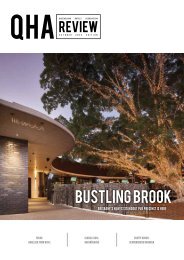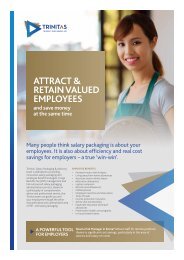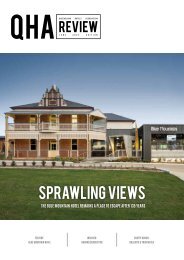QHA-Review_March_Digital
Create successful ePaper yourself
Turn your PDF publications into a flip-book with our unique Google optimized e-Paper software.
Tana Thorpe EMPLOYMENT RELATIONS<br />
Long Service Leave<br />
Long Service Leave (LSL) is a form of paid leave available<br />
to all employees, including casuals. In Queensland, LSL<br />
entitlements are provided by the Industrial Relations Act<br />
2016 (IR Act). Upon 10 years of continuous service, an<br />
employee is entitled to 8.6667 weeks of paid LSL leave,<br />
and there are further entitlements after 10 years. Employees<br />
with between 7 and 10 years’ continuous service will<br />
be entitled to a proportionate payment of LSL if their<br />
employment ends for one of the reasons prescribed in the<br />
IR Act, which include where:<br />
• the employee’s service is terminated by their death;<br />
• the employee terminates their service because of<br />
their illness, incapacity or because of a domestic or<br />
pressing necessity;<br />
• the employer dismisses the employee because of the<br />
employees illness;<br />
• the employer dismisses the employee for a reason other<br />
than the employee’s conduct, capacity or performance<br />
(such as termination as a result of redundancy); or<br />
• the employer unfairly dismisses the employee.<br />
Employers should be aware that not all types of unpaid<br />
leave count towards continuous service. To assist <strong>QHA</strong><br />
members, the <strong>QHA</strong>’s ER team can complete three LSL<br />
calculations per member per calendar year at no cost.<br />
Parental leave<br />
An employee with 12 months continuous service, will be<br />
eligible to take unpaid parental leave where:<br />
• the employee gives birth or adopts a child under 16<br />
years of age; or<br />
• their spouse or de facto partner gives birth; and<br />
• the employee will have responsibility for the care of the<br />
child.<br />
To be eligible for unpaid parental leave, a casual must have<br />
12 months of regular and systemic continuous service<br />
and a reasonable expectation of continuing regular and<br />
systematic work. Eligible permanent and casual employees<br />
may access up to 12 months unpaid parental leave, and<br />
may request to extend the period for a further 12 months.<br />
When resuming work, an employee is entitled to return to<br />
their pre-parental leave position and can make a flexible<br />
work request to reduce or change their hours of work. In<br />
addition to unpaid parental leave, an employee may apply<br />
to Services Australia for parental leave pay.<br />
There are additional leave types that an employee may be<br />
eligible to access, such as:<br />
• unpaid pre-adoption leave;<br />
• unpaid special maternity leave – where an employee<br />
is not fit for work due to a pregnancy-related illness or<br />
due to their pregnancy ending;<br />
• no safe job leave – where an employee cannot work<br />
their position, and another safe job is not available.<br />
The NES details notice, evidence and eligibility<br />
requirements for employees to access parental leave and<br />
associated leave types. <strong>QHA</strong> members who have queries<br />
about parental leave requirements are encouraged to<br />
contact the <strong>QHA</strong>’s ER team.<br />
Family and domestic violence leave<br />
Effective 1 February 2023 (delayed until 1 August 2023<br />
for small business employers), all employees can access<br />
up to ten days paid family and domestic violence leave<br />
each 12-month period. Prior to this, family and domestic<br />
violence leave was an unpaid entitlement of five days.<br />
An employee can access the paid leave to deal with<br />
the impact of the family and domestic violence, where<br />
it is impractical for the employee to do so outside of<br />
the employee’s ordinary hours of work. Actions that<br />
could covered by this leave include attending medical,<br />
legal, police or counselling appointments, attending<br />
legal proceedings, accessing police services and<br />
organising alternative accommodation, care or education<br />
arrangements for children.<br />
Employers are legally required to ensure that the following is<br />
not recorded on an employee’s payslip:<br />
• that an amount paid to an employee is a payment for<br />
paid family and domestic violence leave;<br />
• a period of leave taken by an employee has been<br />
taken as paid family and domestic violence leave;<br />
• an employee’s paid family and domestic violence leave<br />
balance.<br />
The <strong>QHA</strong> has more information available for members on<br />
the introduction of this paid leave type and the specific<br />
rules that apply.<br />
Community service leave<br />
The NES provides that an employee engaged in an eligible<br />
community service activity is entitled to be absent from<br />
work. The NES specifies an eligible community service<br />
activity includes jury service and voluntary emergency<br />
management activities. Where <strong>QHA</strong> members have an<br />
employee who may be eligible for such leave, the <strong>QHA</strong>’s<br />
ER team can provide specific advice about eligibility<br />
criteria, paid or unpaid entitlement and notice and<br />
evidence requirements.<br />
Further assistance<br />
The <strong>QHA</strong> has template employment contracts and<br />
policies, which detail employee’s leave entitlements,<br />
available for purchase as part of the <strong>QHA</strong>’s HR Manual.<br />
This article provides a high-level overview of the different<br />
leave types. <strong>QHA</strong> members seeking further assistance or<br />
wishing to discuss a specific employment relations matter<br />
are encouraged to contact the ER team for a confidential<br />
discussion. Call 07 3221 6999 or email er@qha.org.au.<br />
<strong>QHA</strong> REVIEW | 35

















